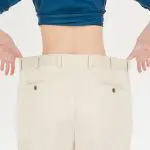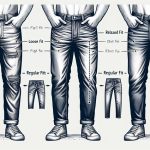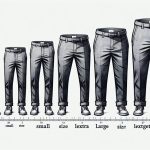Are you wondering how much denim fabric you’ll need to make a pair of pants? Accurate measurements are key. By calculating based on your waist size and accounting for the desired length, fit, and style, you can determine the amount needed.
Don’t forget to factor in extra fabric for pockets and waistbands, and consider pattern matching and fabric width. With these tips, you can minimize waste and maximize your denim usage.
Table of Contents
Understanding the Importance of Accurate Measurements
Accurate measurements are crucial when determining how much denim fabric is needed for one pair of pants. By taking precise measurements, you can ensure that the fabric utilization is optimized, reducing waste and saving costs.
When measuring for pants, it is important to consider various factors such as the waist, hips, inseam, and rise. These measurements will determine how much fabric is required for each part of the pants, including the front and back panels, pockets, waistband, and any additional design elements.
To accurately measure the waist, wrap the tape measure around the narrowest part of your torso. For the hips, measure around the fullest part of your buttocks. The inseam measurement is taken from the crotch to the desired pant length, while the rise measures the distance between the crotch and waistband.
By obtaining accurate measurements, you can calculate the fabric needed for each pattern piece, taking into account any necessary seam allowances. This ensures that you have enough fabric to create a well-fitting pair of pants while minimizing waste.
Accurate measurements are the foundation for successful garment construction, allowing you to create pants that fit perfectly and utilize fabric efficiently.
Calculating the Fabric Needed Based on Waist Size
To figure out the amount of fabric you’ll require, start by measuring your waist size. This is an important step in determining how much denim fabric you’ll need to make a pair of pants that fits you perfectly. Once you have your waist measurement, you can use it to calculate the fabric needed based on the width of the denim and the desired length of the pants.
When choosing the right denim weight, keep in mind that heavier denim tends to shrink more than lighter denim. It’s important to take fabric shrinkage into account when calculating the amount of fabric needed. To ensure you have enough fabric, it’s recommended to add an additional 10-15% to your calculations to account for shrinkage.
Here is a helpful table to guide you in calculating the fabric needed for your pants:
| Waist Size (inches) | Denim Width (inches) | Length of Pants (inches) |
|---|---|---|
| 28 | 60 | 40 |
| 30 | 60 | 42 |
| 32 | 60 | 44 |
| 34 | 60 | 46 |
| 36 | 60 | 48 |
Accounting for the Length of the Pants
When it comes to accounting for the length of pants, it’s crucial to use correct measurement techniques. Factors such as individual height and desired pant style can greatly affect pant length.
Efficient fabric utilization is also an important consideration in order to minimize waste and optimize production.
Correct Measurement Techniques
You’ll need to make sure you’re using the correct measurement techniques when determining how much denim fabric is needed for your pants. Here are some common measurement mistakes to avoid:
-
Not measuring your waist accurately: Make sure to measure around the narrowest part of your waist, which is usually above your belly button.
-
Ignoring the hip measurements: Your hip measurement is crucial for pants that fit well. Measure around the fullest part of your hips to get an accurate measurement.
-
Neglecting the inseam measurement: The inseam measurement determines the length of your pants. Measure from your crotch down to your desired pant length.
-
Forgetting to account for ease: Allow some extra fabric for comfort and ease of movement. Don’t forget to add this to your measurements.
Factors Affecting Pant Length
The factors that affect pant length include inseam measurements and the desired length. When choosing the right pant length, it’s important to consider these factors to ensure a perfect fit. The inseam measurement is the distance from the crotch seam to the bottom of the pant leg. This measurement can vary depending on personal preferences and the style of the pants. The desired length is subjective and can be influenced by factors such as fashion trends and personal style. To help you understand how these factors influence pant inseam, here is a table that provides a visual representation:
| Factor | Description |
|---|---|
| Inseam Measurement | The distance from the crotch seam to the bottom of the pant leg |
| Desired Length | Subjective preference influenced by fashion trends and personal style |
Efficient Fabric Utilization
Now that you understand the factors that affect the length of pants, let’s explore how you can improve fabric efficiency and reduce fabric waste. By implementing these strategies, you can make the most out of your denim fabric and optimize your production process.
Here’s how:
-
Pattern optimization: Carefully plan and layout the pattern pieces on the fabric to minimize waste and maximize the number of garments per yard of fabric.
-
Marker making: Create markers, which are templates that show the placement of pattern pieces on the fabric, to ensure accurate cutting and minimize fabric waste.
-
Grading: Implement efficient grading techniques to minimize fabric consumption while maintaining the desired fit across different sizes.
-
Recycling and repurposing: Explore options for recycling or repurposing fabric scraps to reduce waste and contribute to a more sustainable production cycle.
Factoring in the Desired Fit and Style
When choosing the desired fit and style, it’s important to factor in your body shape and personal preferences. Fit customization allows you to create a pair of pants that flatters your unique figure. Whether you prefer a slim, straight, or relaxed fit, the right style can enhance your appearance and make you feel confident.
To customize the fit, consider your body shape. If you have a pear-shaped figure, opt for a slightly flared or bootcut style to balance out your proportions. If you have an hourglass figure, a high-waisted and fitted style will accentuate your curves. If you have an apple-shaped figure, choose a mid-rise and straight or wide-leg style to create a more balanced silhouette.
Your style preferences also play a significant role in choosing the right fit. Do you prefer a classic and timeless look? Then a straight or bootcut style might be the best choice. Are you into a more trendy and fashion-forward vibe? Then a slim or skinny fit could be the way to go. Remember to consider your comfort level as well. If you prefer a looser fit, opt for a relaxed or boyfriend style.
Considering Additional Fabric for Pockets and Waistbands
Consider adding extra material for pockets and waistbands to enhance the functionality and comfort of your customized pants. By allocating additional fabric for seams, you can ensure that the pockets are deep enough to hold your belongings securely. This extra fabric also allows for more flexibility in the waistband, providing a comfortable fit that moves with your body.
To give you a visual representation, here is a table showcasing the recommended amounts of fabric for pockets and waistbands:
| Pockets | Waistbands | |
|---|---|---|
| 1. | 0.5 yards | 0.25 yards |
| 2. | 0.75 yards | 0.5 yards |
| 3. | 1 yard | 0.75 yards |
Keep in mind that these measurements are approximate and can vary depending on the size and style of your pants. It’s always a good idea to consult your pattern or tailor for more specific recommendations.
Additionally, it’s important to consider the impact of fabric stretch on the fit of your pants. Some fabrics have more stretch than others, which can affect the overall fit and comfort. If you’re using a fabric with a high amount of stretch, you may need to adjust your pattern accordingly to ensure a proper fit.
Adjusting for Pattern Matching and Fabric Width
To ensure a cohesive and visually appealing look, make sure to adjust your pattern for pattern matching and consider the width of your fabric.
When working with denim, it’s important to take into account the potential for fabric shrinkage. Denim is known to shrink, especially when it’s washed for the first time. To avoid any fitting issues with your pants, it’s recommended to prewash your denim fabric before cutting and sewing. This will allow the fabric to shrink before you start working on your pattern.
Additionally, when choosing the right denim weight, consider the style and purpose of your pants. Lightweight denim, around 8-10 ounces, is suitable for summer pants or more relaxed styles. On the other hand, heavyweight denim, around 12-16 ounces, is better suited for durable and structured pants. By selecting the appropriate denim weight, you ensure that your pants will have the desired look and functionality.
Tips for Minimizing Waste and Maximizing Fabric Usage
You can minimize waste and maximize your fabric usage by strategically placing your pattern pieces on the fabric. When cutting out your pattern, it’s important to consider the layout and placement of the pieces to make the most efficient use of your fabric. By doing so, you can reduce fabric waste and save money in the process.
One way to minimize fabric waste is by nesting your pattern pieces. This means arranging them in a way that minimizes the amount of fabric needed. Look for opportunities to fit smaller pieces within larger ones, or place pieces next to each other to avoid unnecessary fabric waste.
Another strategy is to get creative with your fabric utilization. Consider using smaller scraps of fabric for smaller pattern pieces or details. If you have leftover fabric from previous projects, think about incorporating them into your current one. This can add a unique touch to your garment while also reducing waste.
Additionally, consider using pattern layouts that require less fabric. Some patterns offer different cutting layouts for different fabric widths. Opt for the layout that requires the least amount of fabric to further minimize waste.
Conclusion
In conclusion, accurately measuring and calculating the amount of denim fabric needed for one pair of pants is crucial. By considering factors such as waist size, pants length, desired fit and style, and additional fabric for pockets and waistbands, you can ensure an optimal amount of fabric is used.
Don’t forget to adjust for pattern matching and fabric width as well. Following these tips will help minimize waste and maximize fabric usage, ensuring a successful and efficient pants-making process.
- What Fabric Is Chino? Unveiling Chino Material - June 20, 2025
- What Fabric Are Chinos Made From? Exploring Chino Fabric - June 20, 2025
- Chino: Fabric or Style? Understanding the Difference - June 20, 2025





